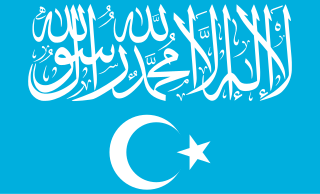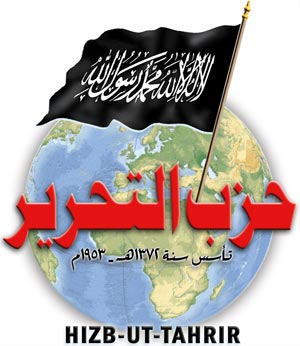Related Research Articles

Central Asia, also known as Middle Asia, is a region of Asia that stretches from the Caspian Sea in the west to western China and Mongolia in the east, and from Afghanistan and Iran in the south to Russia in the north. It includes the former Soviet republics of Kazakhstan, Kyrgyzstan, Tajikistan, Turkmenistan, and Uzbekistan, which are colloquially referred to as the "-stans" as the countries all have names ending with the Persian suffix "-stan", meaning "land of". The current geographical location of Central Asia was formerly part of the historic region of Turkestan, also known as Turan.

The Shanghai Cooperation Organisation (SCO) is a Eurasian political, economic, International security and defence organization. It is the world's largest regional organization in terms of geographic scope and population, covering approximately 60% of the area of Eurasia, 40% of the world population, and more than 30% of global GDP.

The Turkistan Islamic Party (TIP) which has often been confused as the East Turkestan Islamic Movement (ETIM) and other names, is a Uyghur Islamic extremist organization founded in Pakistan by Hasan Mahsum. Its stated goals are to establish an Islamic state in Xinjiang and Central Asia, and eventually a Caliphate. The United States removed the "East Turkistan Islamic Movement (ETIM)," which had been confused as the "East Turkistan Islamic Party / Turkistan Islamic Party," from its list of Terrorist Organizations in 2020, claiming it ceased to exist. However, the U.S. State Department later stated that "ETIM was removed from the list because, for more than a decade, there has been no credible evidence that ETIM continues to exist as the same organization that was conducting terrorist attacks in Syria at the time of their designation." The U.S. State Department further stated that "Uyghur terrorists fighting in Syria and Afghanistan are members of the Turkistan Islamic Party (TIP)"and that the TIP is "a separate organization that China and others have incorrectly identified as ETIM."

The Islamic Movement of Uzbekistan was a militant Islamist group formed in 1998 by Islamic ideologue Tahir Yuldashev and former Soviet paratrooper Juma Namangani; both ethnic Uzbeks from the Fergana Valley. Its original objective was to overthrow President Islam Karimov of Uzbekistan and create an Islamic state under Sharia; however, in subsequent years, it reinvented itself as an ally of Al-Qaeda. The group also maintained relations with Afghan Taliban in 1990s. However, later on, relations between the Afghan Taliban and the IMU started declining.

Central Asia has long been a geostrategic location because of its proximity to the interests of several great powers and regional powers.

The East Turkestan Liberation Organization (ETLO) was a secessionist Uyghur organization that advocated for an independent Uyghur state named East Turkestan in the Western Chinese province known as Xinjiang. The organization was established in Turkey in 1990 or 1996 to fight against the Chinese government in Xinjiang, a territory of ethnic Uyghur majority. ETLO is a designated terrorist organization by the governments of China, Kazakhstan, and Kyrgyzstan.

A. Elizabeth Jones is an American diplomat and government official who served as the United States Ambassador to Kazakhstan from 1995 to 1998 and Assistant Secretary of State for European and Eurasian Affairs from 2001 to 2005. She was promoted to the rank of Career Ambassador in 2004. Most recently Jones served as Chargée d'affaires to India from 2022 to 2023.
Prior to the 2001 invasion of Afghanistan, the Islamic Movement of Uzbekistan (IMU) posed the greatest threat to the Karimov administration. In 2002 the IMU was reclassified as terrorist by the United States. Since the invasion, the IMU has been greatly weakened due to US military actions which cut off its supply of resources and killed its leader, Juma Namangani.
Terrorism in China refers to the use or threatened use of violence to effect political or ideological change in the People's Republic of China. The definition of terrorism differs among scholars, between international and national bodies and across time and there is no legally binding definition internationally. In the cultural setting of China, the term is relatively new and ambiguous.
Terrorism in Tajikistan stems largely from the forces of the political opposition who opposed the comprehensive peace agreement that ended the civil war in 1997. President Emomali Rahmonov and UTO leader Said Abdullah Nuri signed the agreement on 27 June, believing it would bring an end to hostilities. However, dissident Islamist militants led by Tohir Yo‘ldosh and Juma Namangani formed the Islamic Movement of Uzbekistan in 1998, allying with Al-Qaeda and vowing to unite Central Asia as an Islamic state. The latest terror attacks took place in the Qabodiyon District on November 6, 2019, when a policeman and a border guard were killed by several Islamic State militants. 15 terroristi were also killed.
Terrorism in Kyrgyzstan has increased since the U.S. military invaded Afghanistan and overthrew the Taliban in 2001. The governments of Kyrgyzstan and Uzbekistan provided airbases for counter-terrorism operations. Southern Kyrgyzstan is increasingly sympathetic to terrorism and Islamic extremism.

Islam in Central Asia has existed since the beginning of Islamic history. Sunni branch of Islam is the most widely practiced religion in Central Asia. Shiism of Imami and Ismaili denominations predominating in the Pamir plateau and the western Tian Shan mountains, while boasting to a large minority population in the Zarafshan river valley, from Samarkand to Bukhara. Islam came to Central Asia in the early part of the 8th century as part of the Muslim conquest of the region. Many well-known Islamic scientists and philosophers came from Central Asia, and several major Muslim empires, including the Timurid Empire and the Mughal Empire, originated in Central Asia. In the 20th century, severe restrictions on religious practice were enacted by the Soviet Union in Soviet Central Asia and the People's Republic of China in Xinjiang.
The threat of terrorism in Kazakhstan plays an increasingly important role in relations with the United States which in 2006 were at an all-time high. Kazakhstan has taken Uzbekistan's place as the favored partner in Central Asia for both Russia and the United States. Kazakhstan's counter-terrorism efforts resulted in the country's 94th ranking among 130 countries in the 2016 Global Terrorism Index published by the Institute of Economics and Peace. The higher the position on the ranking is, the bigger the impact of terrorism in the country. Kazakhstan's 94th place puts it in a group of countries with the lowest impact of terrorism.

The Islamic Jihad Union is a militant Islamist organization founded in 2002 as a splinter group of the Islamic Movement of Uzbekistan (IMU). Headquartered in North Waziristan, a mountainous region of northwest Pakistan, bordering Afghanistan, the group has been affiliated with both Al-Qaeda and the Taliban.

The Central Asian Union (CAU), later called the Central Asian Economic Union, was an intergovernmental organisation for economic integration between the Central Asian post-Soviet republics of Kazakhstan, Kyrgyzstan and Uzbekistan between 1994 and 2004. Tajikistan joined the Union in 1996 as an observer. Several proposals to restore the Union have been put forward since its dissolution.
Jumaboi Ahmadjonovich Khodjiyev, better known by the nom de guerreJuma Namangani, was an Uzbek Islamist militant with a substantial following who co-founded and led the Islamic Movement of Uzbekistan (IMU) with Tohir Yo'ldosh. The IMU received substantial Taliban patronage, and was allowed to operate freely in northern Afghanistan.
The fight against terrorisminAzerbaijan is one of Azerbaijan's declared priorities. International organizations banned as terrorist include Al Qaeda, Al-Nusra Front, Azerbaijani Jamaat, Hizb ut-Tahrir, Islamic International Brigade, ISIS, Jeyshullah, and PKK. According to the Global Terrorism Database, seven people have been killed and over 20 injured in terrorist attacks from 2000 to 2015.
The 2014 SCO summit was the 13th annual summit of heads of state of the Shanghai Cooperation Organisation held between 11 and 12 September in Dushanbe, Tajikistan. Security was among the top issues for 13th annual summit and all members during the last meeting reached a consensus on fighting against separatism, extremism and terrorism, as well as on safeguarding regional peace and security therefore Afghanistan will be focal point during talks in Dushanbe, claim some diplomats of member countries.

Hizb ut-Tahrir is a pan-Islamist and fundamentalist group seeking to re-establish "the Islamic Khilafah (Caliphate)" as an Islamic "superstate" where Muslim-majority countries are unified and ruled under Islamic Shariah law, and which eventually expands globally to include non-Muslim states. In Central Asia, the party has expanded since the breakup of the Soviet Union in the early 1990s from a small group to "one of the most powerful organizations" operating in Central Asia. The region itself has been called "the primary battleground" for the party. Uzbekistan is "the hub" of Hizb ut-Tahrir's activities in Central Asia, while its "headquarters" is now reportedly in Kyrgyzstan.

The Batken conflict was a period of armed clashes between militants of the Islamic Movement of Uzbekistan (IMU) and the Armed Forces of Kyrgyzstan, with support to the latter being provided by the Uzbek Ground Forces. It was caused by incursions of IMU militants into Uzbek and Kyrgyz territory from Tajikistan and was in part, centered on the unilateral demarcation of the Kyrgyzstan–Uzbekistan border by Uzbekistan.
References
- ↑ U.S.: Diplomat sees growing terrorism challenge in Central Asia RadioFreeEurope/RadioLiberty
- ↑ US warns of instability in Central Asia NDTV
- ↑ Caspian states hold anti-terrorism talks RadioFreeEurope/RadioLiberty